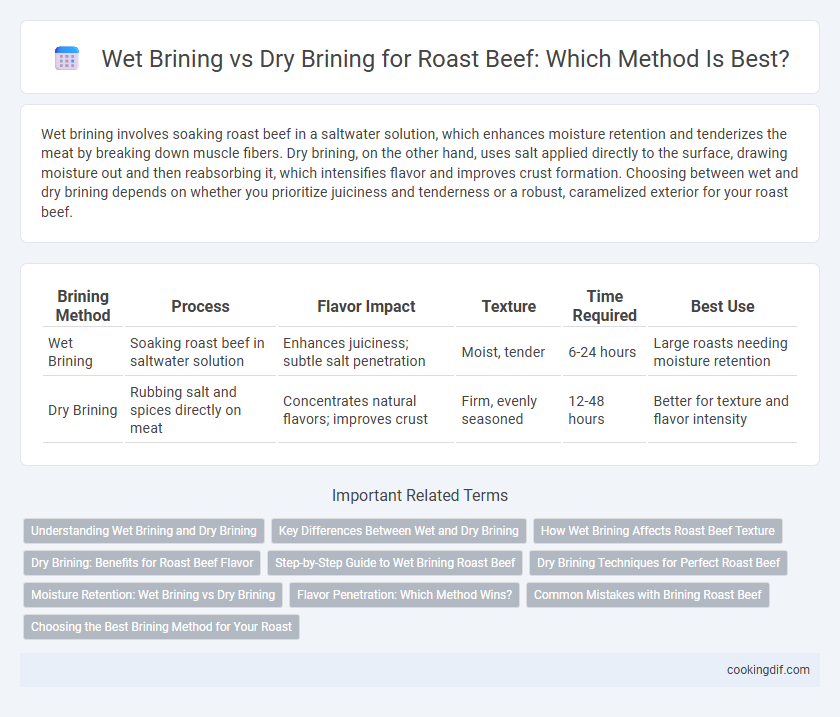Wet brining involves soaking roast beef in a saltwater solution, which enhances moisture retention and tenderizes the meat by breaking down muscle fibers. Dry brining, on the other hand, uses salt applied directly to the surface, drawing moisture out and then reabsorbing it, which intensifies flavor and improves crust formation. Choosing between wet and dry brining depends on whether you prioritize juiciness and tenderness or a robust, caramelized exterior for your roast beef.
Table of Comparison
| Brining Method | Process | Flavor Impact | Texture | Time Required | Best Use |
|---|---|---|---|---|---|
| Wet Brining | Soaking roast beef in saltwater solution | Enhances juiciness; subtle salt penetration | Moist, tender | 6-24 hours | Large roasts needing moisture retention |
| Dry Brining | Rubbing salt and spices directly on meat | Concentrates natural flavors; improves crust | Firm, evenly seasoned | 12-48 hours | Better for texture and flavor intensity |
Understanding Wet Brining and Dry Brining
Wet brining involves submerging roast beef in a saltwater solution, enhancing moisture retention and tenderness by allowing the meat to absorb water and salt. Dry brining coats the surface of the roast with salt, drawing out juices that then reabsorb, intensifying flavor and improving texture without adding extra water. Both methods enhance roast beef quality, but wet brining is ideal for juiciness, while dry brining promotes a concentrated beefy taste and a better crust.
Key Differences Between Wet and Dry Brining
Wet brining involves submerging roast beef in a saltwater solution, enhancing juiciness through moisture absorption, while dry brining uses salt applied directly to the meat's surface, intensifying flavor by drawing out and then reabsorbing natural juices. Wet brines typically require several hours to days and can add a slightly diluted flavor profile, whereas dry brines work more quickly and preserve the roast's original beef flavor with a firmer texture. Key differences include moisture retention, flavor concentration, and preparation time, influencing the overall tenderness and taste of the roast beef.
How Wet Brining Affects Roast Beef Texture
Wet brining enhances roast beef texture by increasing moisture retention, resulting in juicier and more tender meat. The saltwater solution breaks down muscle fibers, which helps prevent dryness during cooking. This method ensures a consistent, soft bite and improved overall mouthfeel in the finished roast.
Dry Brining: Benefits for Roast Beef Flavor
Dry brining enhances roast beef flavor by allowing salt to penetrate the meat, improving moisture retention and intensifying the natural beef taste. This method creates a well-seasoned crust and ensures even seasoning without diluting the meat's texture. Dry brining also reduces cooking time compared to wet brining, making it an efficient technique for tender, flavorful roast beef.
Step-by-Step Guide to Wet Brining Roast Beef
Wet brining roast beef involves submerging the meat in a saltwater solution, typically consisting of water, salt, sugar, and optional herbs, for 12 to 24 hours to enhance moisture retention and flavor. Begin by dissolving 1/4 cup of kosher salt and 1/4 cup sugar in 1 gallon of cold water, then place the beef in a large container and refrigerate it fully submerged in the brine. After the brining period, remove the roast, pat it dry thoroughly, and allow it to rest before seasoning and roasting for optimal juiciness and tenderness.
Dry Brining Techniques for Perfect Roast Beef
Dry brining roast beef involves coating the meat with kosher salt and allowing it to rest uncovered in the refrigerator for 24 to 72 hours, which enhances flavor and tenderness by breaking down muscle proteins. This technique promotes better crust formation during roasting by drawing out moisture and then reabsorbing the seasoned juices, resulting in a juicier and more flavorful roast. For optimal results, use a precise salt-to-meat ratio of about 1 teaspoon per pound, and avoid rinsing the meat before cooking to maintain the concentrated seasoning.
Moisture Retention: Wet Brining vs Dry Brining
Wet brining enhances moisture retention in roast beef by allowing the meat to absorb a saltwater solution, which helps the muscle fibers retain more water during cooking. Dry brining improves moisture retention by promoting salt penetration that breaks down proteins and improves the meat's natural ability to hold juices. Studies show wet brining results in a juicier texture due to increased water content, while dry brining intensifies flavor and preserves moisture through protein modification.
Flavor Penetration: Which Method Wins?
Wet brining uses a saltwater solution to enhance moisture and infuse salt evenly, resulting in a juicy roast beef with mild flavor penetration. Dry brining involves rubbing salt directly onto the meat, drawing out moisture which then reabsorbs, concentrating the beef's natural flavors and creating a more intense, savory profile. For deeper flavor penetration and robust taste, dry brining often outperforms wet brining in roast beef preparation.
Common Mistakes with Brining Roast Beef
Overbrining roast beef in wet brines can result in an overly salty and mushy texture, while underbrining fails to enhance juiciness and flavor. Using too coarse or insufficient salt in dry brines often leads to uneven seasoning and a less tender roast. Ignoring the resting period after brining prevents proper salt absorption, diminishing the overall succulence and taste of the beef.
Choosing the Best Brining Method for Your Roast
Wet brining for roast beef involves soaking the meat in a saltwater solution, enhancing moisture retention and tenderness through salt penetration. Dry brining uses a salt and seasoning rub directly on the surface, intensifying flavor without added water and promoting a crispier crust. Choose wet brining to maximize juiciness and elevate texture, while dry brining suits those seeking concentrated beef flavor and a caramelized exterior.
Wet brining vs dry brining for roast beef Infographic

 cookingdif.com
cookingdif.com